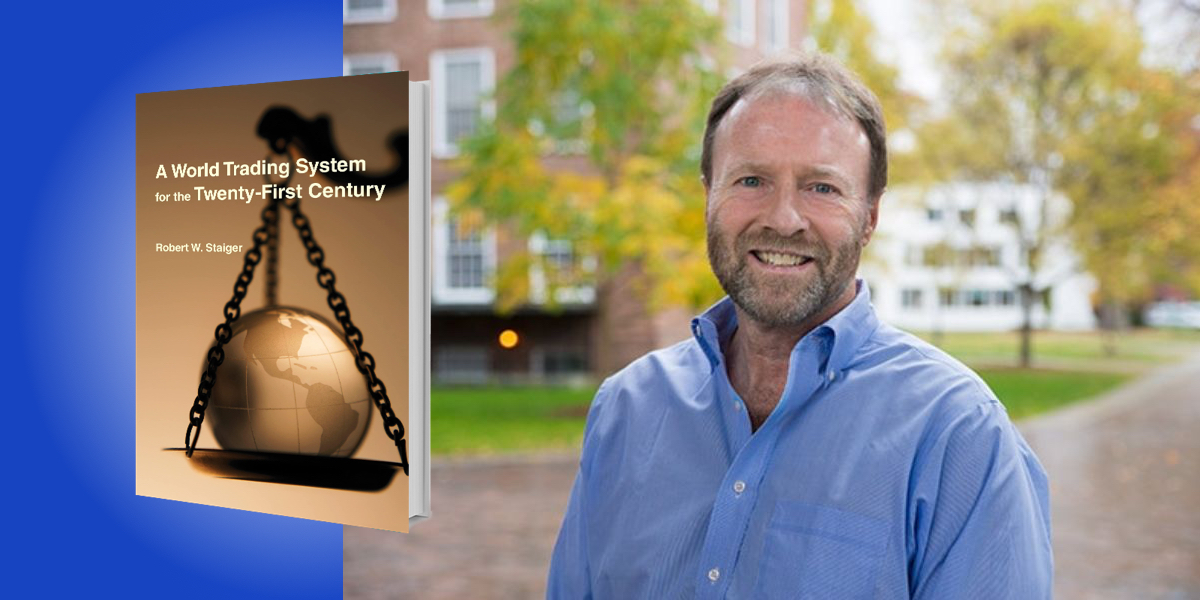Bob Staiger is an economist who teaches international economics at Dartmouth College and a research associate at the National Bureau of Economic Research. He also formerly taught at both the University of Wisconsin and Stanford.
Below, Bob shares 5 key insights from his new book, A World Trading System for the Twenty-First Century. Listen to the audio version—read by Bob himself—in the Next Big Idea App.

1. You don’t have to be a free-trader to support the WTO.
Economists know that their case for free trade depends on special assumptions that may not always hold in the real world. When a country removes an import tariff, there will typically be both winners in the country (such as consumers who enjoy lower-priced imports) and losers (the workers who must compete against those imports). But economists argue that under certain assumptions the aggregate gains from the elimination of tariffs are big enough that the winners could compensate the losers and, in principle at least, everyone in the country could gain. This is the essence of the economist’s case for free trade.
Of course, for many reasons this compensation does not often get paid in the real world, and as a result, tariff cuts have important distributional consequences that each nation must weigh against the aggregate gains. Understandably, countries feel differently about these trade-offs, and this makes it likely that there will be differences across countries in the tariff levels that are appropriate for their goals. For this reason, most economists don’t view the case for free trade as a “one-size-fits-all” policy prescription that applies to all countries at all times.
If the rules of the WTO were built on the case for free trade, then the WTO’s legitimacy as the constitution of the rules-based trading system for its 164 member countries would be suspect.
But WTO rules reflect a logic for each country that, in the jargon of economists, can best be summarized as “Internalize the international externalities of your tariff choices.” This is a logic for good policy choices that is distinct from the case for free trade, and applies far more generally. According to this logic, all countries can better achieve their goals if each country takes into account (that is, internalizes) the costs that it imposes on other countries (the international externality) when it chooses to protect its economy from imports.
WTO rules create an environment where countries are induced to do just that. In this environment, countries are encouraged (through voluntary, WTO-sponsored, negotiations) to lower their tariffs in proportion to the costs those tariffs are imposing on their trading partners. When each country has done this, each has internalized the international externalities associated with its tariff choices, and all countries can gain. This does not necessarily mean that each country will cut its tariffs all the way to free trade, however.
2. The WTO’s shallow-integration approach is a strength, not a weakness.
When a country raises a tariff to protect its economy from imports, foreign producers must reduce their export prices if they want to preserve market share in the country. This harms the exporting countries, but it can benefit the importing country. The importing country would be paying reduced prices at the border for the products it imports from abroad which effectively shifts some of the economic costs of its tariff onto foreign producers. This international cost-shifting leads to what economists call “beggar thy neighbor” tariff choices, because a portion of the country’s gain from its unilateral tariff hike derives from another country’s loss.
“Tariffs dominate all other policies for one purpose, namely, as the best beggar-thy-neighbor cost-shifting tool that a country can wield.”
Beggar-thy-neighbor tariff choices are what WTO rules are designed to eliminate. As described earlier, WTO rules encourage countries to reduce their tariffs to the levels that they would have chosen if they had internalized the costs imposed on foreign exporters—but these are the tariffs they would have chosen in the absence of the international cost-shifting that leads to beggar-thy-neighbor tariffs in the first place! In the WTO, this internalization is accomplished with tariff negotiations between importing and exporting countries, where the exporting country can get the importing country to internalize the cost of the importing country’s tariff on its exporters by offering something of value (usually a tariff cut of its own) to the importing country if the importing country agrees to reduce its tariff.
This is known as the WTO’s “shallow” approach to integration through reciprocal tariff reductions. But what of all the other policies that countries choose, including each country’s behind-the-border policies such as its labor and environmental standards and its health and safety regulations? Wouldn’t the same beggar-thy-neighbor problem extend to these policies, requiring direct international negotiations over all of the country’s policies (i.e., “deep integration”) to solve the problem?
It turns out that the answer is “No.” This is because tariffs dominate all other policies for one purpose, namely, as the best beggar-thy-neighbor cost-shifting tool that a country can wield. Therefore, in the absence of WTO commitments a country’s tariff choices—and only its tariff choices—would be distorted by its ability to shift the economic costs of its policies onto other countries. This means that rather than engaging in fraught negotiations over sensitive behind-the-border policies, as is often attempted with efforts at deep integration that occur outside the WTO, the logic of shallow integration the negotiations can focus on reducing tariffs, with a reliance on a set of additional minimal rules. These rules prevent countries that have agreed to constrain their tariffs at lower levels from subsequently altering their behind-the-border policies to backslide on their negotiated market access commitments. This is essentially how the WTO is designed to work.
The WTO’s shallow-integration approach can therefore be viewed as a strength, not a weakness. Shallow integration avoids trampling on national sovereignty, by imposing the minimal intrusion on a country’s policy choices that can still get at the root causes of the beggar-thy-neighbor problems that the negotiations are meant to solve.
3. China’s economy is compatible with WTO commitments.
Along with its nondiscrimination rules, the WTO operates under a norm referred to as reciprocity. The reciprocity norm holds that tariff reductions negotiated between countries should be balanced and lead to an increase in the volume of each country’s exports that is roughly matched by the increase in the volume of its imports. This norm plays a key role in helping countries eliminate beggar-thy-neighbor cost-shifting incentives from their tariff choices.
The WTO, though, was designed primarily with market economies in mind. How do WTO rules work when applied to a non-market economy such as China, where tariff cuts may not trigger the responses from producers and consumers that would be expected in a market economy? When China joined the WTO in 2001, many observers expected China to evolve steadily toward a market economy. Under this expectation, it was believed that after a brief transition period, the tariff cuts that China agreed to in its accession negotiations would deliver reciprocity. That is, China’s tariff cuts were chosen so that, as China evolved to a market economy, these tariff cuts would deliver increases in its import volumes that roughly matched the increases in its export volumes. These export volumes were expected to occur as a result of the market access commitments that, as a new WTO member, China would receive automatically from existing WTO members under the WTO’s nondiscrimination rules.
However, the expected evolution of China’s economy did not pan out, and it is now clear that China is not likely to evolve into a market economy anytime soon. As a result, the tariff cuts that China agreed to when it joined the WTO are no longer thought to be adequate to deliver reciprocity, and this has been a major source of friction in China’s trade relations with the United States and other WTO members.
So, what is to be done? Is China’s economy incompatible with WTO commitments? This question is not just academic: The possibility of “decoupling” from China is currently a topic of serious discussion in policy circles. These discussions reflect the view that owing to the non-market features of its economy, China’s trade relations with other countries have been nonreciprocal since it joined the WTO.
“Compliance with the WTO’s reciprocity norm works to eliminate beggar-thy-neighbor cost-shifting incentives for non-market economies just as it does for market economies.”
In fact, there are good reasons to think that China’s economy is compatible with WTO commitments, and that decoupling is not the answer. This is because compliance with the WTO’s reciprocity norm works to eliminate beggar-thy-neighbor cost-shifting incentives for non-market economies just as it does for market economies. So, China’s compliance with reciprocity is the real issue, not the fact that China is a non-market economy per se.
The challenge, then, is to find ways that China can comply with the reciprocity norm, given that tariff commitments are not likely to do the trick. The successful experience of Poland, who became a member of the WTO’s precursor organization in 1967, is illuminating. At the time of Poland’s accession negotiations, Poland was a non-market economy with no plans to transition to a market economy, and it was acknowledged that tariff commitments from Poland meant little in terms of access to Poland’s markets. As a consequence, Poland simply agreed to grow its imports from other member-countries by a certain percentage each year to match the growth rate in its exports to those countries that was expected to come from accession. Looking for similarly unorthodox ways that China could make market access commitments consistent with reciprocity is a far better option than decoupling.
4. Climate goals are compatible with WTO commitments.
When a country agrees to lower a tariff in a WTO market access negotiation, it is agreeing to improved conditions of competition for foreign exporters in its market. Rather than the tariff cut per se, it is the commitment to conditions of competition that foreign countries value, and it is this commitment that is legally protected under WTO rules.
What happens then, if, after agreeing to lower its tariff in a WTO negotiation, a country wants to impose a carbon tax on its producers in order to do its part to fight climate change? If the country were held to its existing tariffs, its new carbon tax would disadvantage the country’s producers in their competition with foreign exporters. In effect, by imposing the carbon tax on its producers, the country would be offering additional market access to foreign exporters.
This would have two implications. First, it would make the country’s decision to impose a carbon tax politically more difficult. Second, if foreign exporters produce with carbon-intensive (“dirty”) technologies and don’t similarly face carbon taxes imposed by their own governments, the result would be “carbon leakage,” the partial replacement of domestically produced goods with imports of dirty foreign goods, which would diminish the net carbon reduction achieved by the country’s carbon tax.
This raises the question: Are climate goals incompatible with WTO commitments? The short answer is “No.” The reason can be seen from the nature of the commitments that are legally protected under WTO rules. As noted before, rather than the lower tariffs that a country agrees to in WTO market access negotiations, it is the commitment implied by those lower tariffs to the improved conditions of competition for foreign exporters in its markets that is legally protected under WTO rules. Hence, WTO rules would not prevent the country from combining its new carbon tax with a “carbon border adjustment”—an additional tariff imposed on imports of foreign products—as long as this additional tariff were calibrated to neutralize the adverse market access implications of its new carbon tax. Once calibrated, the carbon border adjustment would eliminate the excess political costs and carbon leakage implications of the new carbon tax just described.
“If the country were held to its existing tariffs, its new carbon tax would disadvantage the country’s producers in their competition with foreign exporters.”
In this sense, climate goals are perfectly compatible with WTO commitments. That said, there is a second possible climate goal that might not be compatible with WTO commitments. This is the possibility that a country would want to raise tariffs above the levels compatible with its WTO market access commitments, in order to incentivize other countries to also impose carbon taxes. A key idea here is that while the compatibility of this second climate goal with WTO commitments is questionable, the compatibility of the first is not in doubt.
5. The WTO may need a hegemon to survive.
An alternative to the rules-based multilateral trading system overseen by the WTO is a power-based approach to solving the problem of beggar-thy-neighbor policies. Under a power-based approach, countries would still negotiate solutions to the international externality problems associated with the unilateral choice of tariffs, but would do so without agreed-upon norms and rules such as reciprocity and nondiscrimination.
In principle, both approaches could solve the problem of beggar-thy-neighbor policies, so what is the advantage of a rules-based system? One advantage of the WTO’s rules-based multilateral system is that its rules and norms simplify the negotiation process by directing countries to focus their negotiations on the root causes of the problem that negotiations are meant to solve. This can increase the chances of successful negotiations.
Relative to a power-based approach, the rules administered by the WTO also diminish the ability of big, powerful countries to exert their bargaining power in the negotiations. Why would a powerful country such as the United States, who along with the United Kingdom created the precursor to the WTO in 1947, agree to tie its hands by submitting to these norms and rules?
A possible reason is that, owing to its status as a hegemon in the early post-war period, the United States understood that it could not convince the other, smaller countries of the world to join in trade negotiations with it unless it could commit not to exploit its dominant position at the bargaining table. According to this view, the rules-based multilateral trading system that the United States championed for most of the twentieth century served effectively as this commitment device.
This interpretation also suggests that, with the rise of large emerging markets led by China in the twenty-first century and the waning hegemonic position of the United States, the United States might no longer see value in tying its hands through a rules-based system. This raises an open question that perhaps can only be answered with the passage of time: Does the rules-based multilateral trading system, and the WTO in particular, need a hegemon to survive? And if it does, what country will serve that role in the twenty-first century?
To listen to the audio version read by author Robert Staiger, download the Next Big Idea App today:































